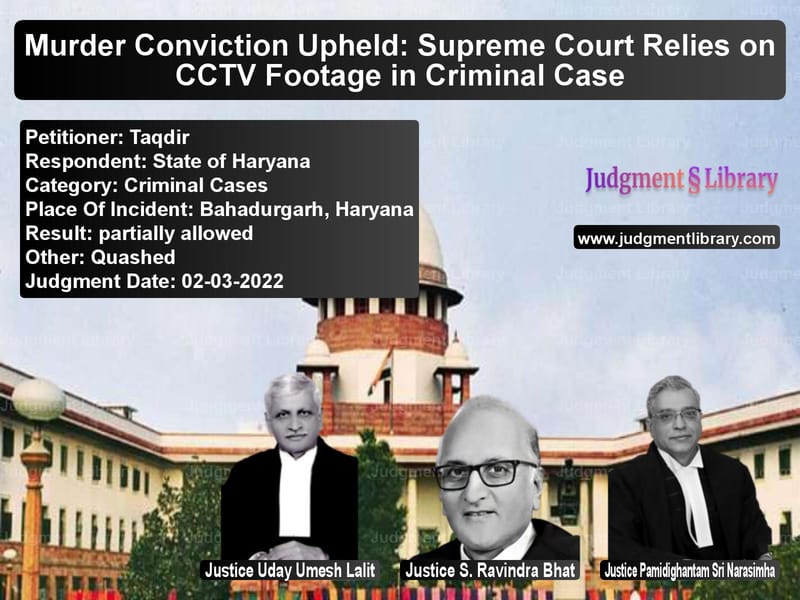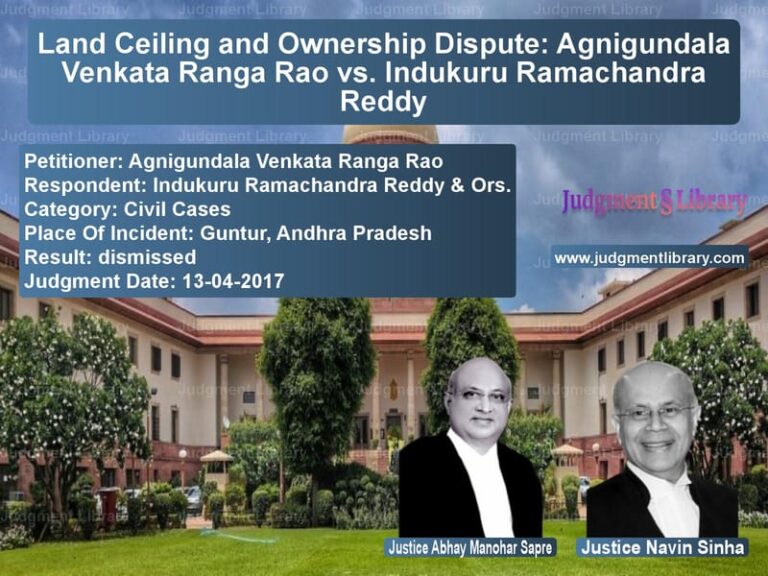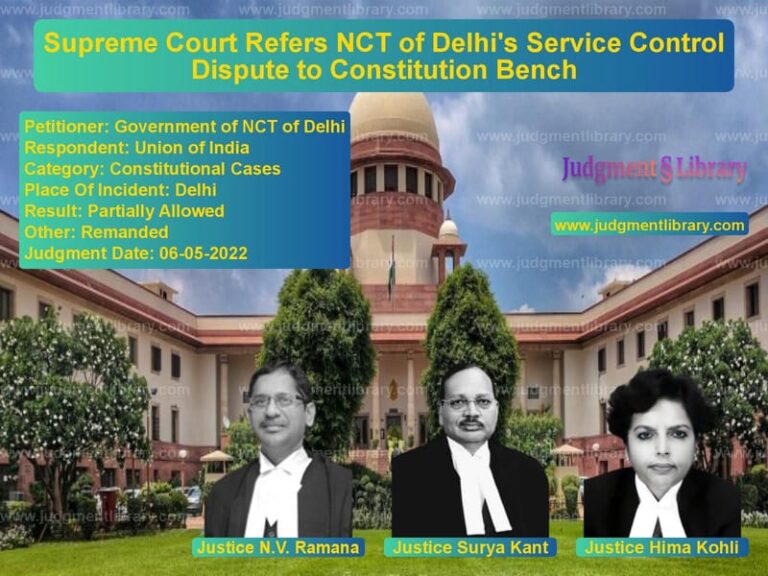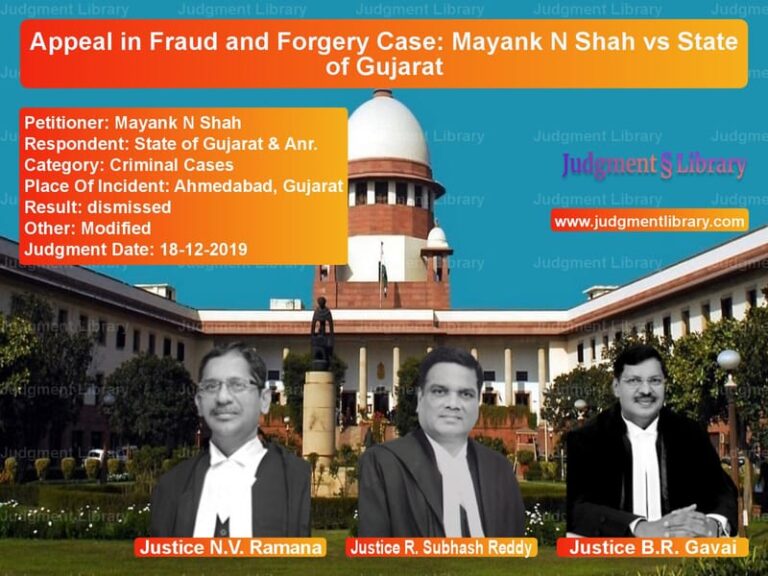Murder Conviction Upheld: Supreme Court Relies on CCTV Footage in Criminal Case
The case of Taqdir vs. State of Haryana revolves around a violent murder committed inside a hospital, captured by CCTV footage, and subsequently used as primary evidence in the trial. The Supreme Court ruled on the admissibility and reliability of electronic evidence while delivering its verdict.
This judgment is significant as it reaffirms the role of CCTV footage as admissible evidence in criminal trials and provides clarity on how courts should interpret electronic evidence in the absence of direct eyewitness testimony.
Background of the Case
The case stemmed from a gruesome murder that took place on June 21, 2010, inside Delhi Hospital, Bahadurgarh. The victim, Rakesh alias Kala, had been admitted for medical treatment when a group of armed assailants stormed into his hospital room and shot him dead. The police registered the case under Sections 148, 149, 302, 307, 449, and 120-B of the Indian Penal Code (IPC) along with Section 25 of the Arms Act.
Read also: https://judgmentlibrary.com/criminal-limitation-period-supreme-court-clarifies-computation-of-time/
The key accused included Taqdir (the alleged mastermind), Kuldeep alias Bhandari, Anil, Jyoti Prakash, and Arun, among others. The police recovered CCTV footage from the hospital, which played a crucial role in identifying the accused and establishing their movements before, during, and after the murder.
Legal Issues Considered
- The validity of CCTV footage as primary evidence in criminal cases.
- The role of circumstantial evidence in proving conspiracy under Section 120-B IPC.
- Whether losing an election can constitute a motive strong enough to establish guilt.
- The requirement for certification under Section 65-B of the Indian Evidence Act for electronic evidence.
Petitioner’s Arguments (Taqdir)
- The defense argued that merely losing an election against the deceased did not amount to sufficient motive to justify conviction.
- There was no direct evidence linking Taqdir to the murder, as he was not present at the crime scene.
- The CCTV footage, though incriminating for others, did not place him inside the hospital at the time of the crime.
- The main accused, Mukesh, who was said to have hired the assassins, was acquitted in a separate trial in 2019.
Respondent’s Arguments (State of Haryana)
- The prosecution argued that Taqdir was the mastermind who conspired with others to eliminate Rakesh due to election-related rivalry.
- Electronic evidence from CCTV cameras, certified under Section 65-B of the Indian Evidence Act, clearly showed the involvement of the other four accused.
- The CCTV footage depicted the assailants entering the hospital with weapons and running out moments after the murder.
- The getaway vehicle used in the crime had been stolen days before, further corroborating the premeditated nature of the attack.
Supreme Court’s Judgment
The Supreme Court bench, comprising Justices Uday Umesh Lalit, S. Ravindra Bhat, and Pamidighantam Sri Narasimha, carefully examined the evidence and made the following key observations:
1. Acquittal of Taqdir Due to Lack of Direct Evidence
“We see force in the submissions advanced by the learned counsel for the appellant and find the material on record to be completely inadequate to return a finding of guilt against appellant Taqdir with the aid of Section 120-B of the IPC, read with Sections 302/307 IPC.”
The Court noted that there was insufficient direct evidence linking Taqdir to the crime, even though he had a motive. Thus, he was acquitted.
2. Conviction of the Four Assailants Based on CCTV Footage
“The sequence of events captured by the CCTV cameras stored in the hard-disk and reproduced as Exs.P86 and P87, duly accompanied by the requisite certification under Section 65-B of the Indian Evidence Act, clearly showed the role played by all these assailants.”
The Court emphasized that the footage, along with forensic and ballistic evidence, confirmed that Kuldeep alias Bhandari, Anil, Jyoti Prakash, and Arun were directly responsible for the murder.
3. Section 65-B Compliance for Electronic Evidence
“The hard-disk was always part of the record and was available in Court. At no stage, any objection was raised or a request was made that the hard-disk itself be played in the Court.”
The Court rejected the argument that the hard-disk was not played in court, ruling that proper certification under Section 65-B was sufficient for its admissibility.
Key Takeaways from the Judgment
- Electronic evidence is admissible if properly certified under Section 65-B of the Indian Evidence Act.
- A mere motive (such as losing an election) is not sufficient to convict an accused without substantive proof.
- CCTV footage can serve as primary evidence in criminal cases, especially when corroborated by other forensic and circumstantial evidence.
- While the mastermind theory can be applied in conspiracy cases, courts require strong evidence beyond just a motive to convict an accused.
Implications of the Verdict
This ruling has significant implications for criminal trials relying on electronic evidence. It establishes a clear precedent that:
- Video footage can be treated as direct evidence if it meets legal admissibility standards.
- Procedural compliance with the Indian Evidence Act is critical in ensuring that electronic records are admitted in court.
- The judiciary requires concrete proof beyond motive to convict an accused under conspiracy charges.
Overall, the Supreme Court’s verdict strengthens the role of electronic surveillance in criminal trials while ensuring that convictions are based on substantial evidence rather than circumstantial inferences alone.
Petitioner Name: Taqdir.Respondent Name: State of Haryana.Judgment By: Justice Uday Umesh Lalit, Justice S. Ravindra Bhat, Justice Pamidighantam Sri Narasimha.Place Of Incident: Bahadurgarh, Haryana.Judgment Date: 02-03-2022.
Don’t miss out on the full details! Download the complete judgment in PDF format below and gain valuable insights instantly!
Download Judgment: taqdir-vs-state-of-haryana-supreme-court-of-india-judgment-dated-02-03-2022.pdf
Directly Download Judgment: Directly download this Judgment
See all petitions in Murder Cases
See all petitions in Attempt to Murder Cases
See all petitions in Criminal Conspiracy
See all petitions in Judgment by Uday Umesh Lalit
See all petitions in Judgment by S Ravindra Bhat
See all petitions in Judgment by P.S. Narasimha
See all petitions in partially allowed
See all petitions in Quashed
See all petitions in supreme court of India judgments March 2022
See all petitions in 2022 judgments
See all posts in Criminal Cases Category
See all allowed petitions in Criminal Cases Category
See all Dismissed petitions in Criminal Cases Category
See all partially allowed petitions in Criminal Cases Category







